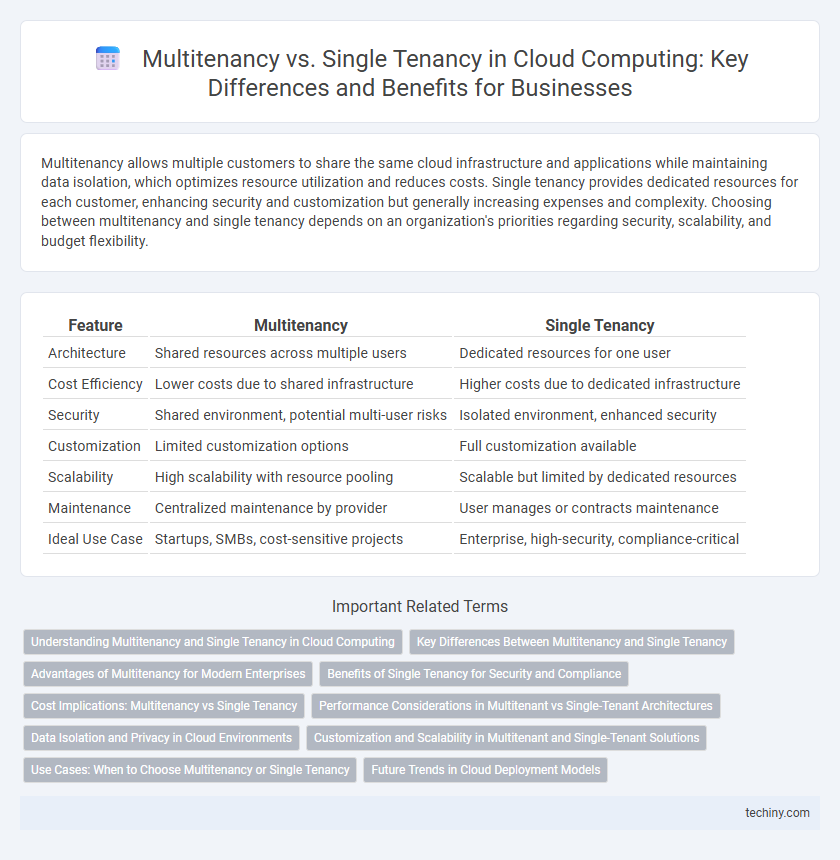Multitenancy allows multiple customers to share the same cloud infrastructure and applications while maintaining data isolation, which optimizes resource utilization and reduces costs. Single tenancy provides dedicated resources for each customer, enhancing security and customization but generally increasing expenses and complexity. Choosing between multitenancy and single tenancy depends on an organization's priorities regarding security, scalability, and budget flexibility.
Table of Comparison
| Feature | Multitenancy | Single Tenancy |
|---|---|---|
| Architecture | Shared resources across multiple users | Dedicated resources for one user |
| Cost Efficiency | Lower costs due to shared infrastructure | Higher costs due to dedicated infrastructure |
| Security | Shared environment, potential multi-user risks | Isolated environment, enhanced security |
| Customization | Limited customization options | Full customization available |
| Scalability | High scalability with resource pooling | Scalable but limited by dedicated resources |
| Maintenance | Centralized maintenance by provider | User manages or contracts maintenance |
| Ideal Use Case | Startups, SMBs, cost-sensitive projects | Enterprise, high-security, compliance-critical |
Understanding Multitenancy and Single Tenancy in Cloud Computing
Multitenancy in cloud computing allows multiple customers to share the same infrastructure and applications while maintaining data isolation, optimizing resource utilization and cost efficiency. Single tenancy dedicates resources exclusively to one customer, enhancing customization, security, and compliance at the expense of higher operational costs. Choosing between multitenancy and single tenancy depends on business needs for scalability, security requirements, and budget constraints.
Key Differences Between Multitenancy and Single Tenancy
Multitenancy allows multiple customers to share the same cloud infrastructure and applications while keeping their data isolated, optimizing resource usage and cost efficiency. Single tenancy provides a dedicated environment for each customer, offering enhanced customization, security, and performance but with higher operational expenses. Key differences include resource sharing versus exclusivity, cost-efficiency versus control, and scalability versus customization.
Advantages of Multitenancy for Modern Enterprises
Multitenancy enables modern enterprises to optimize resource utilization by hosting multiple customers on a single instance, significantly reducing operational costs compared to single tenancy. It enhances scalability and agility, allowing businesses to quickly adapt to changing demands without the need for dedicated infrastructure for each client. Centralized management and automated updates improve security and maintenance efficiency, making multitenancy ideal for dynamic, growth-focused organizations.
Benefits of Single Tenancy for Security and Compliance
Single tenancy offers enhanced security by isolating each tenant's data and applications on dedicated infrastructure, reducing the risk of data breaches common in shared environments. This model simplifies compliance with stringent regulatory standards like HIPAA, GDPR, and PCI DSS by providing clear audit trails and minimizing cross-tenant vulnerabilities. Organizations handling sensitive data prioritize single tenancy to maintain strict control over security configurations and minimize exposure to external threats.
Cost Implications: Multitenancy vs Single Tenancy
Multitenancy significantly reduces operational costs by sharing infrastructure and resources among multiple users, leading to lower hardware and maintenance expenses. Single tenancy incurs higher costs due to dedicated resources for each tenant, increasing expenses for hardware, software licenses, and management. Cost efficiency in multitenancy makes it ideal for startups and businesses with limited budgets, whereas single tenancy suits organizations requiring enhanced security and customization, justifying the higher investment.
Performance Considerations in Multitenant vs Single-Tenant Architectures
Multitenant architectures share resources among multiple users, which can lead to variable performance due to resource contention and noisy neighbors, whereas single-tenant architectures offer dedicated resources, ensuring consistent and predictable performance levels. Performance optimization in multitenancy requires advanced resource isolation and workload management to mitigate the impact of shared environments, while single-tenant systems naturally avoid these issues by design. Enterprises prioritizing workload stability and high-performance SLAs often prefer single-tenant setups, despite the higher operational costs compared to multitenant models.
Data Isolation and Privacy in Cloud Environments
Multitenancy in cloud computing enables multiple customers to share the same infrastructure while logically isolating their data through virtualization and encryption protocols, enhancing resource efficiency but posing potential risks in data privacy due to shared environments. Single tenancy offers dedicated infrastructure for each customer, providing stronger data isolation and enhanced privacy controls at the cost of higher operational expenses and reduced scalability. Organizations prioritizing stringent compliance and security often prefer single tenancy to minimize data leakage risks inherent in multitenant cloud architectures.
Customization and Scalability in Multitenant and Single-Tenant Solutions
Multitenant cloud computing solutions allow multiple customers to share the same infrastructure while maintaining data isolation, offering limited customization but high scalability due to shared resources. Single-tenant environments provide dedicated resources to one customer, enabling extensive customization to meet specific business needs but often resulting in lower scalability and higher costs. Organizations seeking flexible scaling with standardized features typically prefer multitenancy, whereas those requiring tailored configurations and enhanced security often choose single-tenancy.
Use Cases: When to Choose Multitenancy or Single Tenancy
Multitenancy is ideal for businesses seeking cost efficiency, scalability, and simplified maintenance, such as SaaS providers serving multiple clients with shared resources. Single tenancy suits organizations requiring enhanced security, customization, and performance isolation, like financial institutions or healthcare providers handling sensitive data. Choosing between them depends on regulatory compliance needs, budget constraints, and workload characteristics.
Future Trends in Cloud Deployment Models
Future trends in cloud deployment models indicate a growing shift towards hybrid multitenancy architectures that balance cost efficiency with enhanced security and customization. Advances in containerization and microservices enable scalable multitenant environments tailored to specific enterprise needs, while single tenancy continues to serve regulated industries requiring isolated infrastructures. Emerging technologies like AI-driven resource allocation and edge computing further optimize multitenant deployments for performance and compliance.
Multitenancy vs Single Tenancy Infographic

 techiny.com
techiny.com